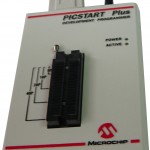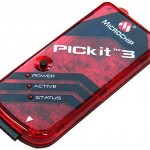PicStartPlus and I have history
I started down my embedded journey using the Microchip PicStartPlus. It was more expensive then most of the other programmers on the market but using it had a satisfying feeling knowing it was constructed by the same company that creates the microchips I would be using.
Having only known the use of a serial programmer I was at home using IC pullers to remove my micro-controllers for proto-board and using IC inserters to prevent bending pins. I became so accustomed to extraction and insertion that I designed my proto-board design around it. Jumpers would run around the chip, care was taken to not have components up to the chip to allow room for insertion, precious space was consumed to aid in the programming of the chip.
An angel in a plastic box
Like most people I was content in my ignorance. In Circuit Programmers/Debuggers sounded cool but how much better could it really be? Can saving a few seconds here and there really contribute to decreasing development time?
My first circuit designed for the PicKit3 was already noticeably smaller, taking up much less of the precious space on my proto-board. Where before I had to run a ground line behind the chip to aid in extraction I could now jump components across and over the micro-controller without fear of having to remove and reinstall them later.
The interface to the PicKit3 does require 5 strips on the proto-board but I’ve found, especially on larger projects, I recover more space from its usage then I lost.
Hardware debugging and what I’ve been missing
Hardware debugging really wasn’t even one of the features I considered when purchasing the PicKit3. I’ve never used it and really never saw it being extremely beneficial. Man was I wrong!
On my current airsoft turret problem I have to establish the minimum and maximum range of motion for two servos. Using the serial programmer I had to write a program that would do usart communications to my PC, edge the servos to the limits of their movement, and have the micro-controller report its timer settings to the PC to be recorded and coded back into the chip to prevent servo damage.
Using the PicKit3 I just created a small program that held both servos into a neutral position, then using MPLABs I manually adjusted the Timer settings to find both servos upper and lower limits, recorded the values, stopped the debugger and shot the new program over into the micro-controller.
An even better approach could have been achieved but uploading my final program to the micro-controller with dummy values for the upper and lower servo limits, used the debugger to find their exact values, reprogram, and marvel at my ingenuity!
Conclusion
All in all I am pleased with the use and performance of the PicKit3 compared to the PicStartPlus. I did expect faster uploading to the chip then I have been experiencing but it does feel like the PicKit3 is substantially faster programming then the PicStartPlus.

